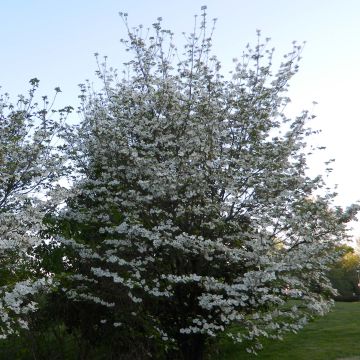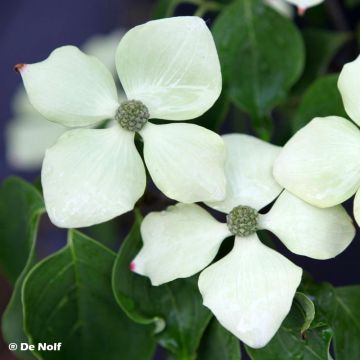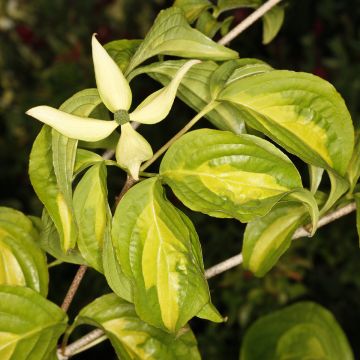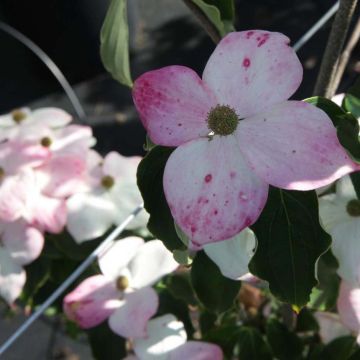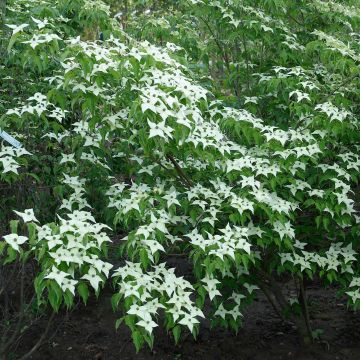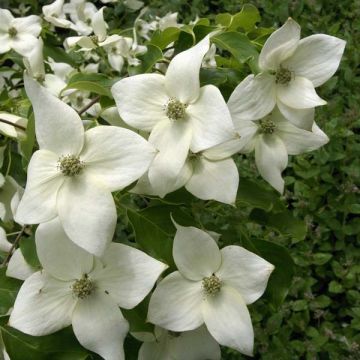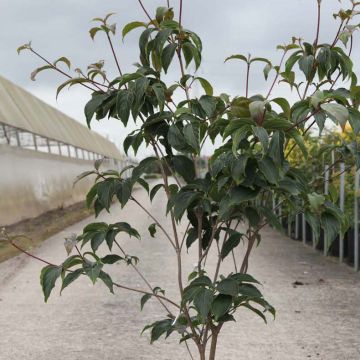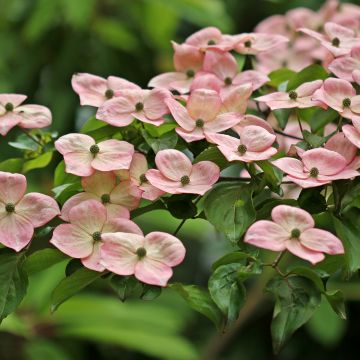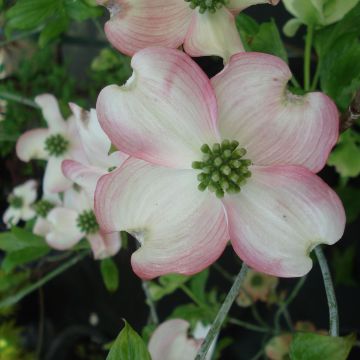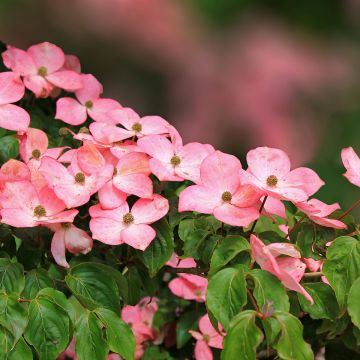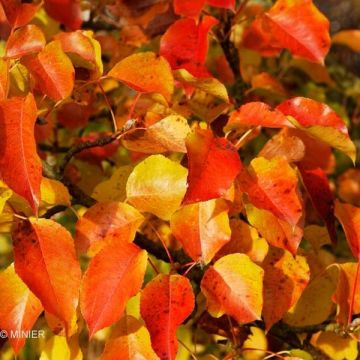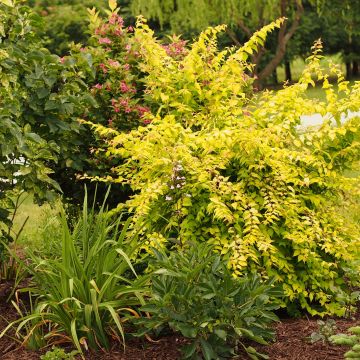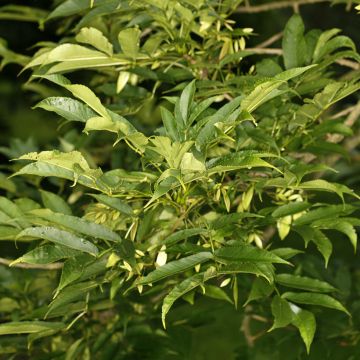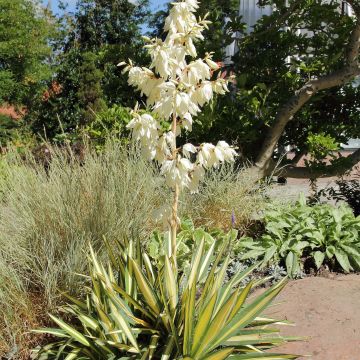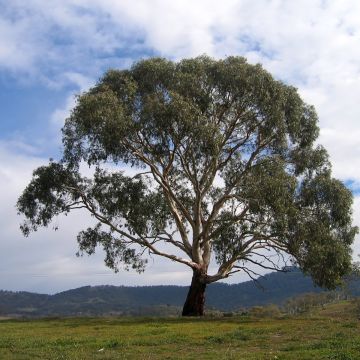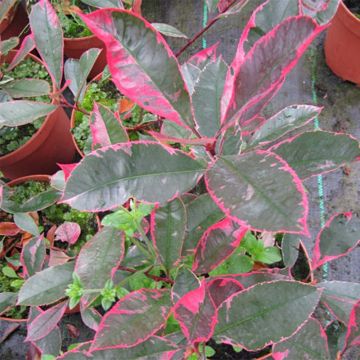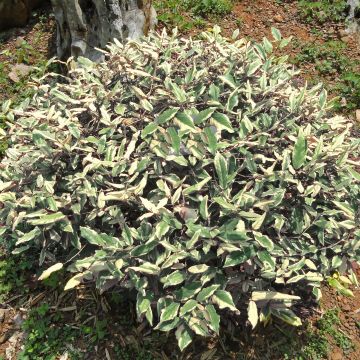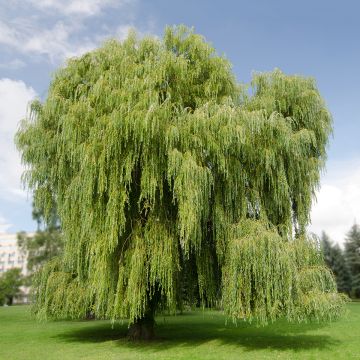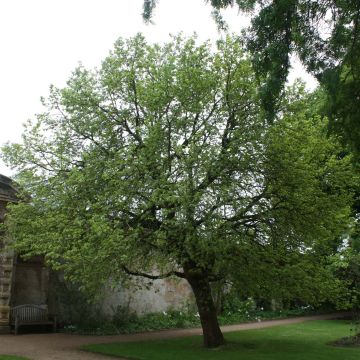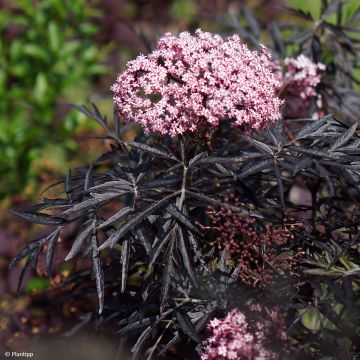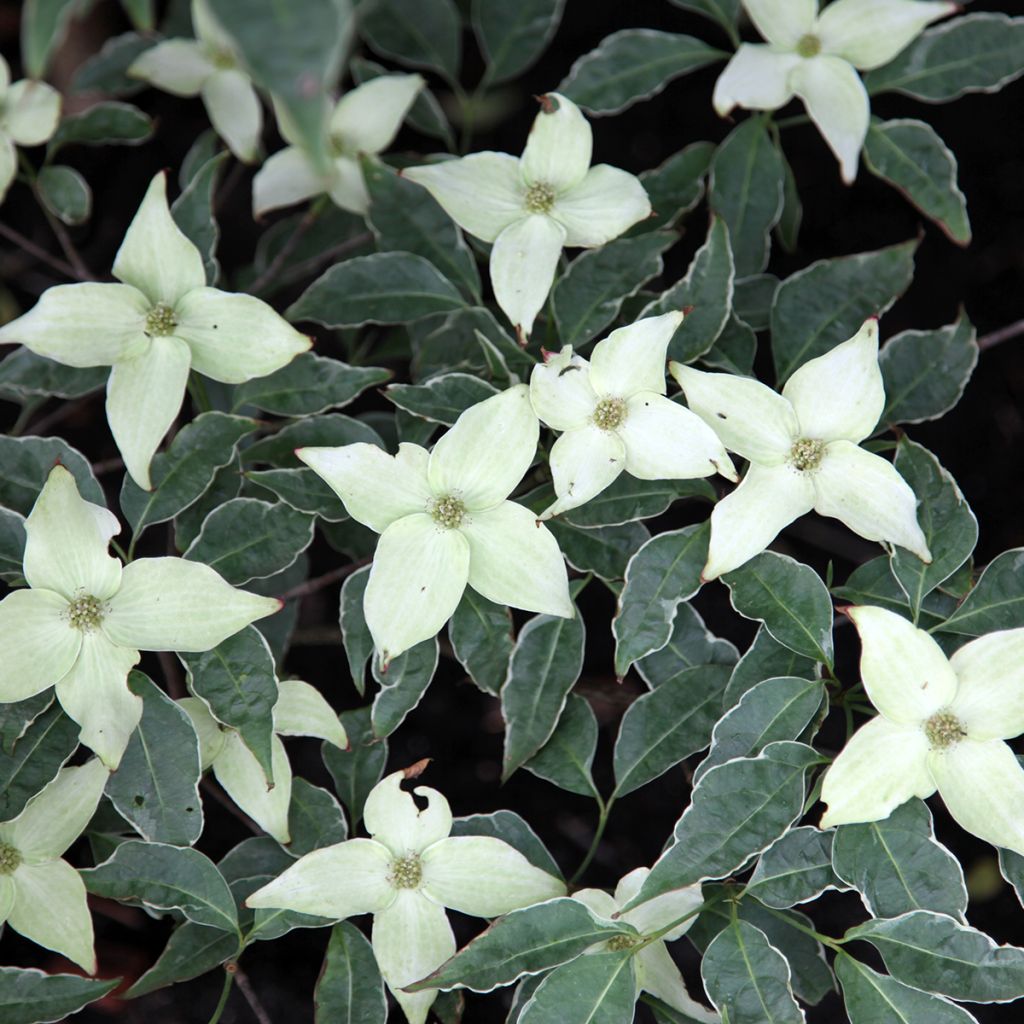

Cornus kousa Pévé Foggy - Flowering Dogwood
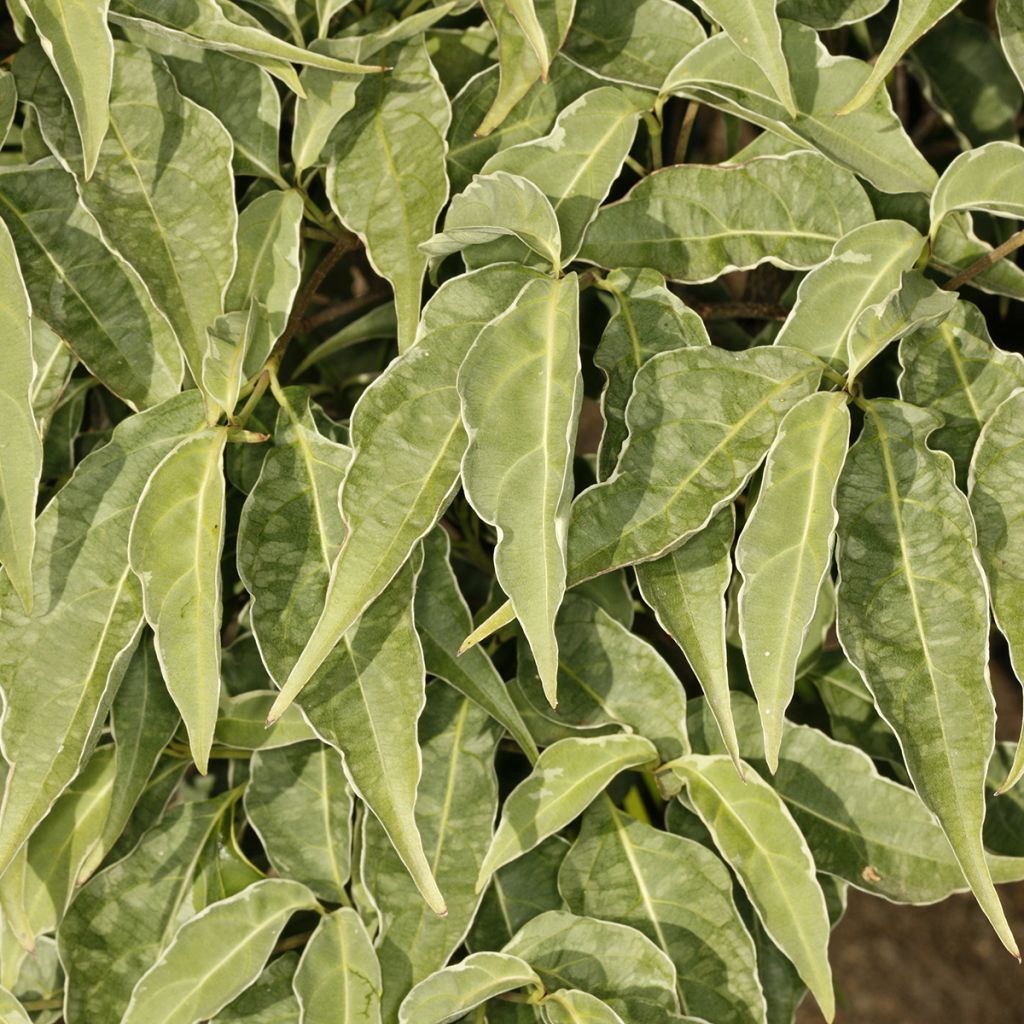

Cornus kousa Pévé Foggy - Flowering Dogwood
Cornus kousa Pévé Foggy - Flowering Dogwood
Cornus kousa Pevé Foggy
Kousa Dogwood, Japanese Dogwood, Chinese Dogwood
This item cannot be shipped to the selected country
Delivery charge from €5.90
More information
Schedule delivery date,
and select date in basket
This plant carries a 24 months recovery warranty
More information
We guarantee the quality of our plants for a full growing cycle, and will replace at our expense any plant that fails to recover under normal climatic and planting conditions.
From €5.90 for pickup delivery and €6.90 for home delivery
Express home delivery from €8.90.
Does this plant fit my garden?
Set up your Plantfit profile →
Description
The Cornus kousa 'Pevé Foggy' is a variety of Japanese Dogwood that will delight fans of original shrubs. With its fine white variegation and elongated leaves with curiously undulating edges, it stands out from the others. However, its flowering is classic, in the form of white four-branched stars. Round berries, quite ornamental, follow in the favour of a sufficiently warm summer. In autumn, the vegetation takes on superb red colours attracting attention in the garden. Fairly vigorous and hardy, this large bush grows in non-limestone, fresh, well-drained soil, sheltered from too much direct sunlight.
The Dogwood belongs to the small family of the Cornaceae, which, after several revisions of the classification, now includes only the genera Cornus and Alangium. The Cornus kousa is a tree of small development or a large bush, native to Japan, China, and Korea. Its graphic silhouette, supported by tiered and horizontal branches, gives it a Japanese appearance. The botanical species has given rise to several horticultural varieties, the result of the work of breeders.
'Pevé Foggy' has characteristic foliage, which will not leave you indifferent. The lanceolate leaves are very elongated, with a tapered and pointed tip. The lamina is slightly V-shaped, and its edges undulate curiously, sometimes causing the leaf to bend slightly on a horizontal plane. A slightly greyish green, the leaf is adorned with a fine cream-white border that runs around the entire periphery, further accentuating the plant's originality.
This Dogwood has slightly faster growth than other varieties, with the stems growing 15 to 40 cm (6 to 16in) per year and a height after 10 years of cultivation of about 2.50 m (8ft). Eventually, it will reach a height of between 3 m (10ft) and 4.50 m (15ft) and a spread of 2 m (7ft) to 3.75 m (12ft). Like other varieties, it produces flower heads in spring (from mid-May to late June) consisting of small spherical flowers in the centre, surrounded by four large white bracts. Each bract has a lanceolate shape and they come together to form a star of approximately 10 cm (4in) in diameter, initially slightly greenish and then turning a beautiful white colour. Very numerous, flowering horizontally just above the foliage, these "flowers" resemble delicately posed butterflies. The "flowers" are followed by 2.5 cm (1in) diameter red fruits, similar to strawberries. The higher the summer temperatures, the more abundant the fruiting. The fruits are edible, fleshy, with a sweet flavour, but they are more ornamental than tasty. Like many other varieties, this Japanese Dogwood finishes the season beautifully when its foliage turns red before falling.
The Cornus kousa 'Pevé Foggy' thrives in continental climates with distinct summers and winters, but also performs well in milder areas. In hot regions, it should be planted in a sheltered location from the scorching sun. You can showcase it by planting it alone on a lawn, which it deserves, as its foliage, flowering, and fruits offer a spectacle throughout the entire growing season. It will also be perfect as a backdrop to a landscaped bed, mixing perennials and shrubs, and even trees in the background under the edge of which it will thrive in very sunny climates. Plant the superb Acer japonicum 'Vitifolium' next to it, a Japanese Maple with large, very architectural palmate leaves, light green in spring, darkening in summer, and then turning a bright orange and crimson red in autumn. To accompany the flowering of your Dogwood, opt for the Chinese Azalea 'Arneson Gem' with large orange-yellow flowers, stunning against the shiny green foliage and contrasting well with the white bracts of 'Pevé Foggy'. And to extend the flowering season, consider Hamamelis, which will reward you with their delicate spider-like flowers in the middle of winter, and Hydrangeas, which will brighten the end of the season with their beautiful flowers.
Report an error about the product description
Plant habit
Flowering
Foliage
Botanical data
Cornus
kousa
Pevé Foggy
Cornaceae
Kousa Dogwood, Japanese Dogwood, Chinese Dogwood
Cultivar or hybrid
Other Flowering Dogwood
Planting and care
Originating from Japan, Korea, and China, Cornus kousa bushes thrive in continental climates and temperate zones. Extremely cold temperatures during winter can result in absent or reduced flowering. Long, hot summers promote fruit ripening. However, this bush is very hardy and can withstand frost down to -15°C (5°F). It tolerates sunny exposures in areas with moderately hot summers. In hot regions, it should be planted in a sheltered spot away from scorching sun.
'Pevé Foggy' appreciates deep, fertile, well-drained soils with a slightly acidic or neutral tendency, without being a true heathland plant, which is too poor and quickly dries out. It greatly appreciates the thick humus of leafy undergrowth. It can tolerate clayey soils as long as it is protected from excess moisture, especially in winter. Plant it in a deep hole lined with clay balls, coarse sand, or gravel to ensure good drainage if necessary, in a very compact soil. Any good, balanced, and pliable garden soil suits it. When planting, provide it with compost and leaf compost. Mulching with pine bark will help maintain freshness in summer and promote soil acidity.
Pruning is not obligatory, but can be done at the end of winter to remove diseased or dead wood and crossing branches in order to maintain an attractive habit. During the first two years after planting, regular watering is necessary in summer, afterwards, it can manage on its own.
Planting period
Intended location
Care
This item has not been reviewed yet - be the first to leave a review about it.
Striking foliage shrubs
Haven't found what you were looking for?
Hardiness is the lowest winter temperature a plant can endure without suffering serious damage or even dying. However, hardiness is affected by location (a sheltered area, such as a patio), protection (winter cover) and soil type (hardiness is improved by well-drained soil).

Photo Sharing Terms & Conditions
In order to encourage gardeners to interact and share their experiences, Promesse de fleurs offers various media enabling content to be uploaded onto its Site - in particular via the ‘Photo sharing’ module.
The User agrees to refrain from:
- Posting any content that is illegal, prejudicial, insulting, racist, inciteful to hatred, revisionist, contrary to public decency, that infringes on privacy or on the privacy rights of third parties, in particular the publicity rights of persons and goods, intellectual property rights, or the right to privacy.
- Submitting content on behalf of a third party;
- Impersonate the identity of a third party and/or publish any personal information about a third party;
In general, the User undertakes to refrain from any unethical behaviour.
All Content (in particular text, comments, files, images, photos, videos, creative works, etc.), which may be subject to property or intellectual property rights, image or other private rights, shall remain the property of the User, subject to the limited rights granted by the terms of the licence granted by Promesse de fleurs as stated below. Users are at liberty to publish or not to publish such Content on the Site, notably via the ‘Photo Sharing’ facility, and accept that this Content shall be made public and freely accessible, notably on the Internet.
Users further acknowledge, undertake to have ,and guarantee that they hold all necessary rights and permissions to publish such material on the Site, in particular with regard to the legislation in force pertaining to any privacy, property, intellectual property, image, or contractual rights, or rights of any other nature. By publishing such Content on the Site, Users acknowledge accepting full liability as publishers of the Content within the meaning of the law, and grant Promesse de fleurs, free of charge, an inclusive, worldwide licence for the said Content for the entire duration of its publication, including all reproduction, representation, up/downloading, displaying, performing, transmission, and storage rights.
Users also grant permission for their name to be linked to the Content and accept that this link may not always be made available.
By engaging in posting material, Users consent to their Content becoming automatically accessible on the Internet, in particular on other sites and/or blogs and/or web pages of the Promesse de fleurs site, including in particular social pages and the Promesse de fleurs catalogue.
Users may secure the removal of entrusted content free of charge by issuing a simple request via our contact form.
The flowering period indicated on our website applies to countries and regions located in USDA zone 8 (France, the United Kingdom, Ireland, the Netherlands, etc.)
It will vary according to where you live:
- In zones 9 to 10 (Italy, Spain, Greece, etc.), flowering will occur about 2 to 4 weeks earlier.
- In zones 6 to 7 (Germany, Poland, Slovenia, and lower mountainous regions), flowering will be delayed by 2 to 3 weeks.
- In zone 5 (Central Europe, Scandinavia), blooming will be delayed by 3 to 5 weeks.
In temperate climates, pruning of spring-flowering shrubs (forsythia, spireas, etc.) should be done just after flowering.
Pruning of summer-flowering shrubs (Indian Lilac, Perovskia, etc.) can be done in winter or spring.
In cold regions as well as with frost-sensitive plants, avoid pruning too early when severe frosts may still occur.
The planting period indicated on our website applies to countries and regions located in USDA zone 8 (France, United Kingdom, Ireland, Netherlands).
It will vary according to where you live:
- In Mediterranean zones (Marseille, Madrid, Milan, etc.), autumn and winter are the best planting periods.
- In continental zones (Strasbourg, Munich, Vienna, etc.), delay planting by 2 to 3 weeks in spring and bring it forward by 2 to 4 weeks in autumn.
- In mountainous regions (the Alps, Pyrenees, Carpathians, etc.), it is best to plant in late spring (May-June) or late summer (August-September).
The harvesting period indicated on our website applies to countries and regions in USDA zone 8 (France, England, Ireland, the Netherlands).
In colder areas (Scandinavia, Poland, Austria...) fruit and vegetable harvests are likely to be delayed by 3-4 weeks.
In warmer areas (Italy, Spain, Greece, etc.), harvesting will probably take place earlier, depending on weather conditions.
The sowing periods indicated on our website apply to countries and regions within USDA Zone 8 (France, UK, Ireland, Netherlands).
In colder areas (Scandinavia, Poland, Austria...), delay any outdoor sowing by 3-4 weeks, or sow under glass.
In warmer climes (Italy, Spain, Greece, etc.), bring outdoor sowing forward by a few weeks.

































